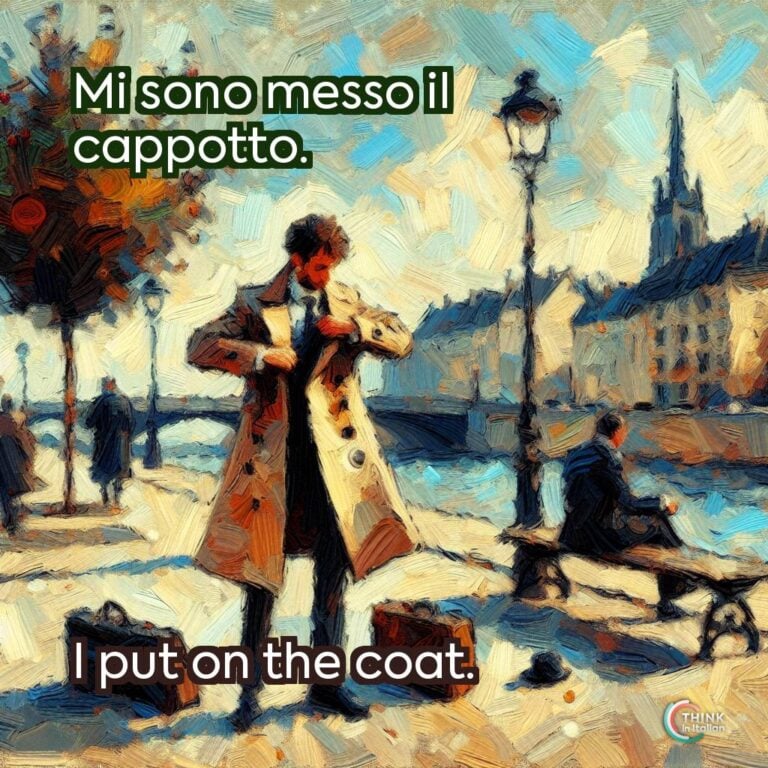Italian Reflexive Verbs
Reflexive verbs, or verbi riflessivi in Italian, are a special type of transitive verbs where the subject and the object coincide.
Look at the following pair of sentences:
- Transitive non-reflexive verb:
Io lavo il mio cane.
I wash my dog.
Io is the subject, lavo is the verb, and il mio cane is the direct object of the sentence: in fact, the verb is a transitive verb and therefore the object is directly linked to it without the use of any preposition.
- Reflexive verb:
Io mi lavo.
I wash myself.
Io is the subject as above, lavo is the verb, but here mi is a reflexive pronoun that stands for me stesso/a (myself). This object is still a direct object, because the verb is still a transitive verb, but in this case it coincides with the subject.
It is the same as if saying:
Io mi lavo = Io lavo me stesso/a.
I wash myself.
However, some verbs behave like reflexive verbs, but technically they’re not reflexive. They’re called riflessivi impropri (false reflexives), and this is what I will be discussing in this article.
“Riflessivi Impropri” in Italian
Different Types of False Reflexives
In Italian, there are 3 types of riflessivi impropri:
- Forma riflessiva apparente (apparent reflexive form);
- Forma riflessiva reciproca (reciprocal reflexive form);
- Forma pronominale (pronominal form).
Here, I will discuss the first one: verbi riflessivi apparenti (apparent reflexive verbs).
Apparent Reflexive Form
The verbi riflessivi apparenti (apparent reflexive verbs) are verbs in which the pronouns (mi, ti, si, ci, vi) are not used as direct objects, but as indirect objects.
To be specific, in linguistics this is called benefactive construction: it is a syntactic structure that makes use of a special kind of transitive verbs which take an indirect object as argument. This indirect object is a beneficiary of the action described by the verb.
Let me give you an example of a benefactive construction before we move to apparent reflexive verbs:
Ho aggiustato la bici a Matteo.
I fixed Matteo’s bike. (lit. I fixed the bike to Matteo.)
Here, a Matteo is grammatically classified as an indirect object because it is a noun introduced by the preposition a. To be precise, as we saw, it is a benefactive.
When it comes to reflexive verbs, these apparent reflexive pronouns “to oneself“, where the “self” is the beneficiary of the action. For example:
Le ragazze si pettinano i capelli. = Le ragazze pettinano i capelli a sé stesse
The girls brush their hair. (lit. The girls brush hair to themselves).
In this case, the subject le ragazze (the girls) is performing the action of pettinarsi (to brush one’s hair) on the direct object i capelli (the hair), with si meaning “to themselves”, referred to le ragazze.
Riflessivi Apparenti: Conjugation
Apparent reflexives are conjugated in the exact same way as reflexive verbs. The only difference is the grammatical function of the reflexive pronouns.
The direct consequence is that riflessivi apparenti must always be followed by an object, and cannot stand alone. Let me show you some examples.
| Presente | |||
| Comprarsi (to buy) |
Pettinarsi (to brush) |
Mettersi (to put on) |
|
| io | mi compro | mi pettino | mi metto |
| tu | ti compri | ti pettini | ti metti |
| lui, lei, Lei | si compra | si pettina | si mette |
| noi | ci compriamo | ci pettiniamo | ci mettiamo |
| voi | vi comprate | vi pettinate | vi mettete |
| loro | si comprano | si pettinano | si mettono |
Io mi sono comprata una gonna nuova.
I bought myself a new skirt.
*I mi sono comprata.
*I bought myself.
As you can see, the second sentence is incorrect, because it lacks a direct object which is mandatory to fulfil the meaning of the verb comprare.
Remember: when you conjugate reflexive verbs in the passato prossimo(present perfect), they always require the auxiliary essere(to be).
Here are some more examples:
Oggi non mi sono pettinata i capelli.
Today I did not brush my hair.
Per uscire Giorgia si è messa un vestito.
To go out, Giorgia put on a dress.




